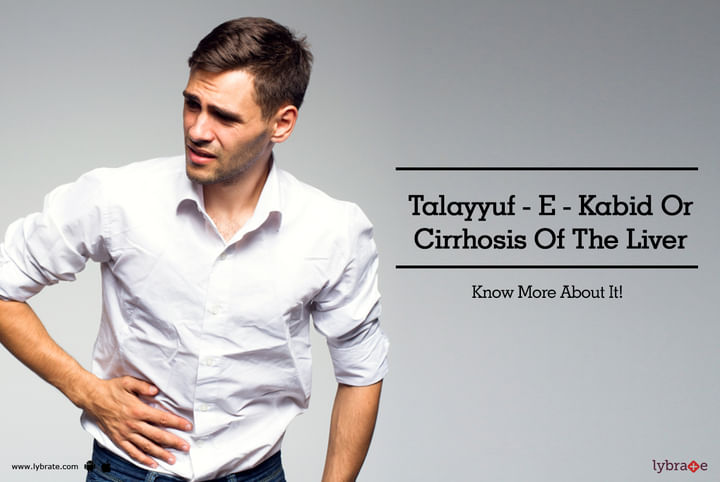Talayyuf - E - Kabid Or Cirrhosis Of The Liver - Know More About It!
It is a slowly and gradually progressing disease in which healthy liver tissue is replaced with scar tissue, hence preventing the liver from proper functioning. The developed scar tissue blocks the flow of blood through the liver and slows the processing of nutrients, hormones, drugs, and naturally produced toxins. It also slows the production of proteins and other substances made by the liver. Cirrhosis is a complication of liver disease which involves loss of liver cells and irreversible scarring of the liver. In other words, Cirrhosis is a condition in which the liver does not function properly due to long-term damage. Typically, the disease comes over months or years.
Although there are many other causes for cirrhosis, the commonest is excessive use of alcohol, viral hepatitis B and C infections and non-alcoholic fatty liver disease. Thus the scarring is most often caused by long-term exposure to toxins such as alcohol or viral infections.
According to the National Institutes of Health, it is the 12th leading cause of death. Men are more prone to develop cirrhosis than women. Globally approximately 57% of cirrhosis is attributable to either hepatitis B (30%) or hepatitis C (27%).Alcohol consumption accounting for about 20% of cirrhosis.
Persons most commonly affected: Adults of both sexes.
Unani approach to Cirrhosis of Liver (Talayyuf-e- Kabid)-
In Unani literature Cirrhosis of the liver is known as “Talayyuf-e- kabid”, “Sighr-al- kabid” or “Jigarki laghari”. It is of two types.
1. AcuteType of Cirrhosis of Liver (Talayyuf-e- Kabid Hadd)-
It is rare but very dangerous. It is also called Yarqaan-e- khabees or Huzaal-e- asfar. Mainly occurs due to inflammation in hepatic cells, in which hepatic cells squeeze in few days resulting in improper functioning of liver. It is a disease in which cells throughout the liver are destroyed. Although they are replaced by areas containing normal new cells but also by much scar tissue, which alters the structure of the liver.
Causes and risk factors: Excessive use of alcohol/ chronic alcoholism, poor nutrition, highly toxic condition of the body system, viral infections caused by chronic viral hepatitis (types A, B and C), metabolic diseases such as alpha-1-antitrypsin deficiency, galactosemia and glycogen storage disorders,inherited diseases such as Wilson's disease and hemochromatosis, biliary cirrhosis, toxic hepatitis due to severe reactions to prescription drugs or prolonged exposure to environmental toxins and repeated bouts of heart failure with liver congestion etc.
Signs and Symptoms: The main signs and symptoms of this type are jaundice, pain at the site of liver, vomiting, headache, dizziness, increased body temperature, increased pulse rate, brownish coloured and dry tongue, increased thirst, initially whitish coloured diarrhoea, later on, colour becomes blackish due to contamination of blood, urine passes in less quantity and reddish in colour due to contamination of yellow bile in it, haemorrhage from nose, stomach, intestine and uterus even abortion in women are seen. The size of the liver feels small on palpation.
2. Chronic type of Cirrhosis of Liver (Talayyuf-e- KabidMuzmin)
This type of the disease occurs due to the improper blood supply to the hepatic cells resulting in the size of liver very small in appearance but liver cells stay normal.
Causes and risk factors: The main causes of this type are the application of permanent pressure at the site of the liver such as ascites, alcohol abuse, hepatitis C virus infection, cardiomegaly, poor nutrition, highly toxic condition of the body system, peritoneal inflammation, improper diet in old age and starvation etc. Other causes which develop this disease are, obstruction of the external bile duct by stone, scar, inborn defect or tumour, use of certain medications, syphilis and passive liver congestion. Obesity has recently been recognized as a risk factor in non-alcoholic hepatitis and cirrhosis.
Signs and Symptoms: It is a slowly progressing disease. In early-stage symptoms, of indigestion like flatulence, constipation and diarrhoea may be present. General weakness, the feeling of being unwell, loss of appetite, loss of weight, and a loss of interest in sex may also be there. There may be a dull abdominal ache, nausea and vomiting. Eventually, the patient dies due to anaemia or ascites. The feeling of dullness is the peculiar sign of the disease. Other symptoms and signs include low-grade fever, bad breath, jaundiced skin and bloated and swollen abdomen.
Complications and Risks associated with Cirrhosis of Liver (Talayyuf-e-Kabid)-
Ascites (retention of fluid in the abdominal cavity) is the most common complication of cirrhosis and is associated with a poor quality of life, increased risk of infection and a poor long-term outcome. Other potentially life-threatening complications are hepatic encephalopathy (confusion and coma) and bleeding from oesophageal varices. Cirrhosis is generally irreversible, and treatment usually focuses on preventing progression and complications. In advanced stages of cirrhosis, the only option is a liver transplant.
Preventive measures for cirrhotic patients (Talayyuf-e- Kabid ke Mareezon ke liye Ehtiyaati Tadaabir):
- Cirrhotic patients must completely avoid alcohol. Alcohol accelerates liver failure and hastens death in cirrhotic patients.
- Avoid liver toxins. Acetaminophen (Tylenol), should be avoided because they can be toxic in cirrhotic patients.
- Juice therapy helps the liver to detoxify toxins from the body. Cirrhotic patients should mix one part of pure juice with one part of water before drinking.
- Cirrhotic patients are strongly advised to eat smaller meals. To avoid overworking the liver, five or six smaller, lighter meals per day are recommended.
- Avoid fatty foods and processed foods, especially foods prepared with animal fats or hydrogenated oils. These types of foods put additional load on the liver.
- Cirrhotic patients are also advised to eat only lean proteins (containing no fats) and in limited amounts.
- Vegetable proteins are very beneficial in Cirrhotic patients. High protein intake causes increases of ammonia levels in the blood, possibly resulting in mental confusion, and in severe cases, coma. However, do not severely limit protein intake, as this may cause protein deficiency and impair the healing process.
- Routinely increase consumption of fruits and steamed vegetables as fruits and vegetables are easy to digest, thus less work for the liver. In addition, they are good sources of vitamins, minerals, and antioxidants that help the liver detoxify and heal.
- Cirrhotic patients are advised to practice intermittent fasting.
- They are also advised to protect against hepatitis B, C and E.
Fundamentals of Management in Unani Medicine-
- Identify the cause of the disease and treat it accordingly
- Correct the digestive processes
- Use hot dresses
- Use mild and early digestible diet
- In case of ascites treat it
Management/ Treatment-
In Unani medicine, very effective treatment is available for the Cirrhosis of Liver by strengthening the Liver cells and restoring normal size and functions of the Liver. In Unani medicine, there is a number of hepatoprotective drugs that protect the Liver either acute or chronic type.
- SootshekharRas Swarna yukta 125 Mg twice a day
- PittariAvleh 10 gm twice a Day
Duration of the treatment: 3 to 6 months or it depends upon the condition of the patients. If the patients with cirrhosis have diabetes, then the treatment may take long time for curing the disease. Diet plays a key role along with Unani Medicines. Hence, it is strictly advised to follow a proper diet plan.



+1.svg)
